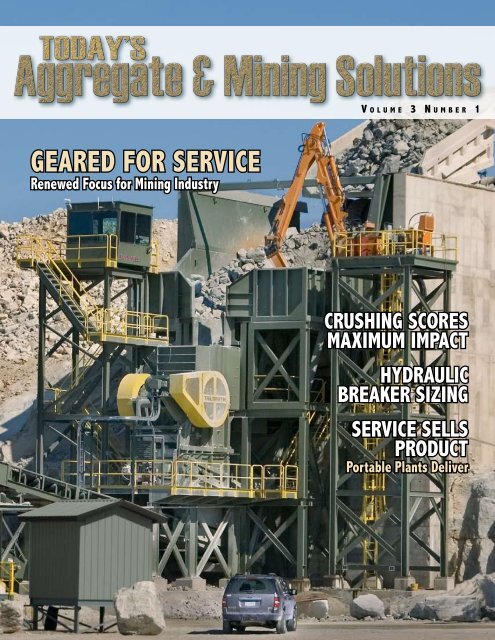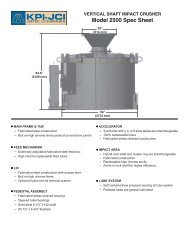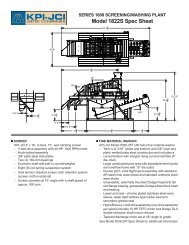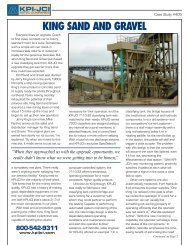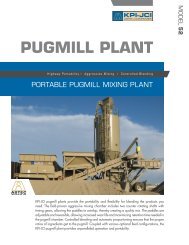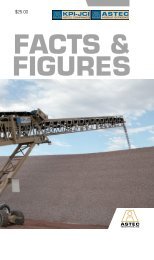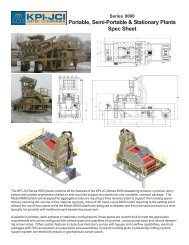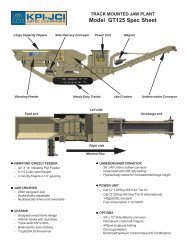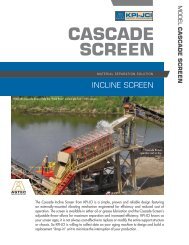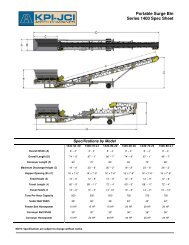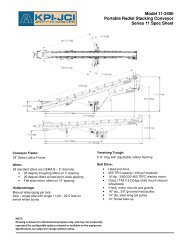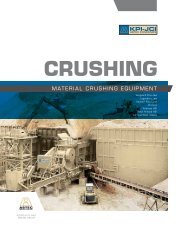Download Today's Aggregate and Mining Solutions - Vol 3 ... - KPI-JCI
Download Today's Aggregate and Mining Solutions - Vol 3 ... - KPI-JCI
Download Today's Aggregate and Mining Solutions - Vol 3 ... - KPI-JCI
- No tags were found...
Create successful ePaper yourself
Turn your PDF publications into a flip-book with our unique Google optimized e-Paper software.
COMPANY LISTINGS:<strong>Vol</strong>ume 3, Number 1Today’s <strong>Aggregate</strong> & <strong>Mining</strong> <strong>Solutions</strong> is published by Highl<strong>and</strong>sPublications on behalf of the <strong>Aggregate</strong> <strong>and</strong> <strong>Mining</strong> Group of AstecIndustries, Inc., to provide informative <strong>and</strong> educational industry news <strong>and</strong>articles to aggregate <strong>and</strong> mining professionals.On The Cover:Carmeuse—Cedarville Plant,modular primary crushingstation receives a fresh loadof material from a 150-tonhaul truck.Photo courtesy of Telsmith, Inc.an Astec Industries Inc. CompanyAstec Mobile Screens2704 West LeFevre RoadSterling, Illinois 61081toll free: (800) 545-2125tel: (815) 626-6374fax: (815) 626-6430sales@astecmobilescreens.comwww.astecmobilescreens.comSubscriptionsFor a FREE subscription to Today’s <strong>Aggregate</strong> & <strong>Mining</strong> <strong>Solutions</strong>,visit www.myaggmag.com.For a FREE subscription to Today’s Recycling <strong>Solutions</strong>, visitwww.myrecyclemag.com.Customer Service/Address ChangesTo make changes to your subscription, please contact Jackie Keul.800.765.6601262.242.5812jkeul@telsmith.comPublications Mail Agreement No. 40624074Return undeliverable Canadian addresses to:PO Box 503RPO West Beaver CreekRichmond Hill ON L4B 4R6Editorial CommentsIf you have any comments about the content of the magazine, pleasecontact Highl<strong>and</strong>s Publications Editor Donna Campbell at 866.251.1777,ext. 101, fax 205.824.9796, or e-mail dcampbell@highl<strong>and</strong>spublications.com. Correspondence may be mailed to:Highl<strong>and</strong>s Publications, Inc.312 Lorna SquareBirmingham, Alabama 35216 USACopyright: All material appearing in Today’s <strong>Aggregate</strong> & <strong>Mining</strong> <strong>Solutions</strong> magazine is copyrighted.Reproduction in whole or in part is strictly forbidden without permission in writing from the editor.Contributions: Freelance contributions <strong>and</strong> submissions are welcomed by this magazine. No responsibilityis accepted for unsolicited manuscripts, photographs, <strong>and</strong> transparencies. The opinions expressed bycontributors are not necessarily those of the publisher. All statements made, although based on informationbelieved to be reliable <strong>and</strong> accurate, cannot be guaranteed <strong>and</strong> no fault or liability can be accepted forerror or omission.©2010. All rights reserved.Breaker Technology, Inc.35 Elgin StreetThornbury, OntarioCanada N0H 2P0Kolberg-Pioneer700 W 21st StreetYankton, South Dakota 57078toll free: (800) 542-9311fax: (605) 665-8858Osborn Engineered ProductsSA (Pty) Limited57 Jansen RoadEl<strong>and</strong>sfontein, South Africa 1406(PO Box 8182)Telsmith, Inc.PO Box 539Mequon, Wisconsin 53092toll free: (800) 567-8267tel: (519) 599-2015fax: (519) 599-6803sales@rockbreaker.comwww.rockbreaker.comJohnson Crushers86470 Franklin Blvd.Eugene, Oregon 97405toll free: (800) 314-4656fax: (541) 736-1424www.kpijci.comtel: +27 11 820 7600fax: +27 11 388 1136osborn@osborn.co.zawww.osborn.co.zatoll free: (800) 765-6601tel: (262) 242-6600fax: (262) 242-5812sales@telsmith.comwww.telsmith.comAs a commitment to the environment, AstecIndustries chose Chorus Art paper, whichcontains 50% recycled content, including 25%post-consumer waste, <strong>and</strong> is FSC certified (ForestStewardship Council).Keep, pass, or recycle this magazine.Contact your regional representative.Please visit www.aggminegroup.com
contents33 HYDRAULIC BREAKER SIZINGSelection criteria snapshot.34 KEY ISSUE FOR THEEXTRACTIVE INDUSTRYThe European <strong>Aggregate</strong>s Association outlinesits ongoing campaign to improve accessto raw materials in the EU.34 EUROPEAN MINERALSCONFERENCE MADRID 201035 madrid raw materialsdeclaration 20103036 BAUMA 2010 MARKEDA TURNAROUND FORTHE INDUSTRYAttendance hit record levels.2833
emphasis on being physically closerto the customer to better assess thecustomer’s needs. By being in the samesocial scene <strong>and</strong> seeing situationsfirsth<strong>and</strong>, we were able to developa relationship with the customer<strong>and</strong> establish an open channel ofcommunication. This lead to a clearunderst<strong>and</strong>ing of thecustomer requirements<strong>and</strong> allowed us to developa product portfolio thatbetter met the customer’sneeds; this was a clearcompetitive advantagefor us.”In 2004, Olsen movedback to Milwaukee,Wisconsin, as presidentof Metso’s sales <strong>and</strong>service operations inNorth America <strong>and</strong>Central America. In2007, he joined SuperiorHighwall <strong>Mining</strong>, asmall manufacturer ofspecialized coal miningequipment in Beckley, West Virginia.The company was later sold to Terex<strong>and</strong> Olsen assumed the role of director,responsible for the sales <strong>and</strong> serviceorganizations around the world for Terex<strong>Mining</strong>. Shortly before Olsen joinedAstec, Bucyrus International acquired theTerex <strong>Mining</strong> division.NEW ROLE WITH ASTECAs Astec Industries’ Vice President<strong>Mining</strong> Sales, Olsen is tasked withimproving the sales <strong>and</strong> service networkto best be able to deliver the company’sservices <strong>and</strong> products to its globalcustomer base.“To join a company with a reputationfor excellent services <strong>and</strong> products thatare well suited to addressing the needsof the mining industry is an excitingopportunity,” says Olsen. “To be pairedwith a st<strong>and</strong>ard of excellence <strong>and</strong> peoplealready committed to accomplishingthe goal of quality customer service isrewarding, <strong>and</strong> I look forward to takingAstec to the next level of service.”Olsen brings an underst<strong>and</strong>ing of theglobal mining markets to his currentposition <strong>and</strong> takes from his pastexperience a wealth of life lessons<strong>and</strong> h<strong>and</strong>s-on expertise. An example isOlsen’s experience at Superior Highwall<strong>Mining</strong>. He was recruited to take abusiness that was Appalachian-focusedJohn Olsen is Astec Industries’ Vice President <strong>Mining</strong> Sales <strong>and</strong> brings a strongcustomer-service focus to current mining operations.<strong>and</strong> build its international business. Thiscompany made highly specialized coalmining equipment for a niche market.After making some changes in the goto-marketstrategy <strong>and</strong> focusing on themajor coal mining markets, the companywas able to make some good inroadsinto the Russian, Australian, <strong>and</strong> Indianmarkets that resulted in the placement ofequipment in those countries.MINING OPERATIONS CHALLENGEAs Olsen sets a course for improving thesales <strong>and</strong> service network for the miningdivision of Astec Industries, his role willinclude a complete review of the currentdistribution network to determine whatgaps exist <strong>and</strong> then establish a plan ofaction to address those gaps.“We will assess where we are currently<strong>and</strong> decide where we want to be, <strong>and</strong>the plans put in place will be executedto deliver the desired results. The gapswill vary by market, <strong>and</strong> by clearlyidentifying the needs in each market,we can effectively remedy any issue …what’s not working; how to be moreefficient; <strong>and</strong> how to provide the bestcustomer service experience possible.It’s important that the determined nextsteps are favorable <strong>and</strong> all parties arein agreement with the plans to moveforward.”Olsen plans on doing agood bit of travel in hisnew position with Astec<strong>and</strong> will be developinga distribution <strong>and</strong> salesnetwork focused on bestmeeting the customer’sneeds. “Being closer to thecustomer is a key elementto reach the next level ofcustomer service. I wantto know how long it takesfrom the time a customerorders a part to whenthe part can be delivered<strong>and</strong> what’s the timeframefor getting a servicetechnician onsite to getequipment up <strong>and</strong> running.With a keen underst<strong>and</strong>ing of theprocesses in play within the company,the correlation of how important thecustomer service portion of the businessis to growing your capital equipmentsales can be understood <strong>and</strong> successachieved.”ISSUES FACING THE MINING INDUSTRYWhen it comes to issues facing themining industry, Olsen sees the following:• Health <strong>and</strong> Safety. The numberone issue for mining companies istheir employees’ safety followedclosely by protection of theenvironment. This is simply an issuethat is forefront in the industry.• Environmental/Political. Anumber of issues fall into thiscategory, among them: a) Riskassociated with companies forcedto prospect in remote <strong>and</strong> politicallyvolatile parts of the world in search ofeconomically viable ore bodies; b) taxpolicy volatility as evidenced by theToday’s aggregate & mining solutions | volume 3, number 1 5
Australian Resources Super Profit Tax(RSPT); c) while the industry in generalsupports sustainable development, thegrowing sensitivity towards the miningoperation’s environmental impact haslengthened the process of bringingproperties on line <strong>and</strong> leftentire regions off limits;d) the varying regulationschallenging miningcompanies who operate ona global basis.• Shortage of skilledworkers. <strong>Mining</strong>companies have largeworkforces with diverseskills <strong>and</strong> operations,often in numerouslocations across the world.Relocating employees(<strong>and</strong> their families), oftento developing countries where bothliving <strong>and</strong> working conditions arechallenging, adds a further dimension<strong>and</strong> complexity to recruiting <strong>and</strong>retaining a workforce with therequisite skills <strong>and</strong> experience.The aging workforce, downturn instudents from mining fields such asmining engineering <strong>and</strong> geology, <strong>and</strong>socio-political challenges all add to ashortfall of quality workers.• Declining ore grades <strong>and</strong> increasingstrip ratios or depths of mining leadsto higher capital investments per tonof product leading to an intense focuson cost reduction through productivity,energy savings, machine availability,etc by our customers. Most of thequality ore bodies in what areconsidered politically safe areas toinvest have already been developed.<strong>Mining</strong> companies are now forced todevelop properties that are of a lowergrade <strong>and</strong>/or at depths that requirelarger investments per ton of product.It is this higher investment per ton ofproduct that has mining companiesfocused on cost reduction throughproductivity, energy savings, machineavailability, etc.Although the issues are daunting, theycan be overcome <strong>and</strong> companies canfind ways to meet these challenges <strong>and</strong>move forward. By taking an active role topromote safety, align with environmentalsafeguards, sponsor students in miningcareers, <strong>and</strong> find ways to decrease costswith the right equipment coupled withsuperior customer service, the obstaclesbecome opportunities to advance miningoperations on all fronts, securing theindustry for generations to follow.LOOKING FORWARDWith respect to mining companies CAPEX(capital expenditures), Olsen expects(based on industry magazine reports <strong>and</strong>mining companies’ data) that the miningindustry is returning to the investmentlevels of 2007 <strong>and</strong> 2008, which werepeak years.“I expect to see CAPEX return to theselevels going forward,” says Olsen. “Andglobal urbanization, industrialization,<strong>and</strong> infrastructure building will continue<strong>and</strong> drive annual growth rates of 7 to 9percent in the mining industry.”“When looking at China, the consumptionof energy <strong>and</strong> metal is an example ofglobal urbanization. People are movingfrom the rural areas to the cities <strong>and</strong>becoming consumers of tangible goods.During my first trip to China about 20years ago, it was normal to see peoplewalking or riding bicycles, <strong>and</strong> nowthere is a large dem<strong>and</strong> for vehicles.These differences are now also seenin the building taking placeversus years ago. Peoplein developing countries arebecoming more consumeroriented.As a nation’s peoplebecome more consumer-based,there needs to be an expansionof roads, ports, <strong>and</strong> rail tomove the material to reach theconsumers. This has led to theincrease in the mining industrythat has been seen in the last10 years <strong>and</strong> will continue todrive the industry for years tocome.”APPLYING A LIFE LESSONThroughout Olsen’s career, the lessonslearned across his various positionshave been with customer service <strong>and</strong>distribution.“It’s one thing to sell a piece ofequipment—the sales person sells thefirst piece of equipment <strong>and</strong> then yourcustomer service sells every piece ofequipment to that customer after that. Ifyou don’t service that customer well withthat first sale, then it’s expontentiallyharder to sell any additional equipment tothat customer.”That’s the biggest lesson Olsen haslearned <strong>and</strong> it hasn’t changed over theyears: Great customer service takeseffort <strong>and</strong> planning, plus quality in theequipment <strong>and</strong> parts to support theendeavor along with a company culturethat supports it.“I believe that my experience will allowgrowth in the international markets thatthe Astec <strong>Aggregate</strong> <strong>and</strong> <strong>Mining</strong> Grouphas established <strong>and</strong> I will continue tostrengthen our approach the to miningmarket.” ■Wantmore?For more information on the mining division of Astec Industries, e-mail jolsen@astecindustries.comor visit www.astecindustries.com.6 volume 3, number 1 | Today’s aggregate & mining solutions
News–DevelopmentsICMM RELEASES NEW GUIDANCEON PREVENTING FATALITIESThe International Council on <strong>Mining</strong> &Metals (ICMM) is pleased to presentLeadership Matters: Managing Fatal RiskGuidance, a new tool for the miningindustry. It focuses on the proactiveactions <strong>and</strong> behaviors that may beexercised by managers of operations<strong>and</strong> site leadership teams to helpeliminate the risk of fatalities.Leadership Matters expresses the intentthat leaders set the tone <strong>and</strong> directionof “What is Important” through visible<strong>and</strong> felt leadership. It presents aseries of self-diagnostic prompts—builtaround an internationally recognizedrisk management framework—to helpidentify gaps in safety managementsystems.Leadership Matters: Managing Fatal RiskGuidance should be read in conjunctionwith ICMM’s earlier report aimed atchief executives <strong>and</strong> corporate leaders—Leadership Matters: The Elimination ofFatalities.Both reports provide checklist-basedadvice on three key themes:• Live the vision of zero fatalities• Focus on high potential events• Recognize the fallibility of people<strong>and</strong> systemsFor further information, please contactAndrew Mackenzie at info@icmm.com.<strong>KPI</strong>-<strong>JCI</strong> FINISHES 2009WITH PERFECT SAFETY RECORDSafety was definitely on everyone’smind at Kolberg Pioneer, Inc. (<strong>KPI</strong>-<strong>JCI</strong>)in Yankton, South Dakota, as the finaldays of 2009 came to a close. Withalmost 600,000 man hours worked, nota single safety incident had been puton the books. An annual zero incidentrate was indeed achieved at the endof December, an accomplishment neverbefore reached at Kolberg Pioneer, Inc.Focusing in 2010 with the mindset thatsafety is a total team effort <strong>and</strong> witha bar set high, Kolberg Pioneer, Inc.aims to keep the trend going. With anestablished environment centered aroundsafety, it’s sure to be another successfulsafety year. For more, visit www.kpijci.com.MSHA LAUNCHES SAFETY INITIATIVEAIMED AT ROOF FALL PREVENTIONThe U.S. Department of Labor’s MineSafety <strong>and</strong> Health Administrationlaunched its annual roof fall preventionawareness program aimed at reducingthe high number of roof falls that occurin the nation’s underground coal mines.Statistics show that more accidents <strong>and</strong>injuries from roof falls occur during thesummer months than at any other time ofyear. As temperatures rise, humidity <strong>and</strong>moisture increase underground, makingit easier for a mine roof or rib to fall.“Underground roof falls continue to be aleading cause of coal mining fatalities,”said Joseph A. Main, assistant secretaryof labor for mine safety <strong>and</strong> health.“Miners <strong>and</strong> mine operators are urgedto pay attention to roof conditions—notjust in summer, but throughout the year.Since 2000, there have been 69 coalmining fatalities attributed to “fall of roofor back <strong>and</strong> fall of face/rib/pillar/side/highwall.”Federal mine inspectors will distributeeducational information includingposters <strong>and</strong> hardhat stickers to remindthe coal industry about potential hazards<strong>and</strong> suggested remedies. MSHA officialswill speak directly to miners aboutthe problems warmer weather causesfor underground mines <strong>and</strong> presentthem with pertinent statistics about theincrease in accidents during the warmerweather months.<strong>KPI</strong>-<strong>JCI</strong> ROLL-PACK CONVEYORS AREPERFECT SOLUTION FOR PORTABLEPRODUCERS<strong>KPI</strong>-<strong>JCI</strong> introduces the perfect solution forportable in-pit conveyors <strong>and</strong> producerswho are always on the go. The new Roll-Pack series of conveyors feature theability to quickly transport <strong>and</strong> unload upto 210 feet of conveyors in just minutes.They are portable enough to move fromjobsite to jobsite in one load, reducingdowntime. When it’s time to relocate thesystem simply restack the three units withthe st<strong>and</strong>ard built-in roller system <strong>and</strong>move to the next jobsite.The new Roll-Pack series are availablein 60 <strong>and</strong> 70 foot lengths <strong>and</strong> 30 or 36inch belt widths. All conveyor units arejig welded lattice frames with designspecifications for long service life,requiring minimal maintenance.For more information on the Roll-Pack<strong>and</strong> other material h<strong>and</strong>ling products that<strong>KPI</strong>-<strong>JCI</strong> manufactures, please visit www.kpijci.com/material-h<strong>and</strong>ling.STEALTH TAPPET FEATURE AVAILABLEON ALL AMS’S HIGH FREQUENCYSCREENING PRODUCTSAstec Mobile Screens is pleased toannounce that the stealth tappet is nowavailable on not only the ProSizer ® butall their other high-frequency screens aswell. The tappet, which is the mechanismthat shakes the screen cloth, features thesame technology as the previous screen8 volume 3, number 1 | Today’s aggregate & mining solutions
One Si n g u l a r So l u t i o nSeveral years ago, the CarmeuseLime <strong>and</strong> Stone Quarry inCedarville, Michigan, hit a door-diepoint—“either rebuild its entirecrushing facility, or flounder,” says SiteManager Ray LeClair, who was hired onas the go-to-guy to get a new plant up<strong>and</strong> running. The challenge was replacingequipment from the 1930s which hadbeen relocated to Cedarville in the 1950swhere it had operated with no upgradesother than maintenance for the next 50-plus years. The original primary crusherwas located nearly a mile <strong>and</strong> a half fromthe quarry face requiring three costly150-ton trucks to haul material from theface to the primary feeder. “The planthad experienced numerous breakdownswith equipment that was just worn out.Upgrading was the right thing to do.We could reduce hauling, energy <strong>and</strong>A heavy-duty, 8’ x 20’, double deck scalping screen processes as much as 1,600 tph of 12” minus stone.10 volume 3, number 1 | Today’s aggregate & mining solutions
A major dolomitic limestone operation turns to Telsmithas a single source to meet multiple processing goals.maintenance costs, all while increasingour productivity <strong>and</strong> profitability,” saysLeClair.Project planning began in 2007 withthe major initiative being the design ofa new two-stage crushing system in thepit, closer to the quarry face. Crushedmaterial would then travel on a newlyinstalled 4,000-foot conveyor to anexisting surge pile <strong>and</strong> rail load-outsystem. Material loads onto a private 14-car rail system to be transported 5 milesto an existing finishing plant <strong>and</strong> shiploading facility where the product is thentransported on freighters to numerousGreat Lakes ports. More than 60 percentof the operation’s products supply thesteel industry.LeClair says that the project started outon the fast track <strong>and</strong> was scheduled tobe online in July of 2008. But progressslowed when then owner Oglebay Nortonsold the facility to Carmeuse Lime <strong>and</strong>Stone in February 2008. After someamount of evaluation by the new owners,<strong>and</strong> modification of the desired yield <strong>and</strong>stone gradation, the project continued<strong>and</strong> the new crushing facility wascompleted <strong>and</strong> started up in the spring of2009.Throughout the changes in design <strong>and</strong>ownership, <strong>and</strong> into installation, startup,A 600 hp, 68SBS cone crusher incorporates the TRAC10 cone automation giving the operators towercontrol over the 1,300 tph throughput.production, <strong>and</strong> current troubleshooting<strong>and</strong> diagnostics, one thing remainedconsistent—a solid, close collaboration<strong>and</strong> working relationship between LeClair<strong>and</strong> plant manufacturer Telsmith, Inc., thecompany chosen to design <strong>and</strong> engineerthe new crushing system. According toLeClair, Telsmith ultimately simplifieda complex process by managing theproject as a “singular source backed bya combination of resources.”IN-HOUSE DESIGN & ENGINEERINGAfter researching a number of plants<strong>and</strong> operations, LeClair says he choseTelsmith for its in-house design <strong>and</strong>engineering team. “From the verybeginning, I worked closely with oneengineer who was designated as thepoint person—although he did have thesupport of his entire staff. We narrowedthe focus to just two people—he <strong>and</strong> I.All questions would be funneled throughToday’s aggregate & mining solutions | volume 3, number 1 11
us. This streamlinedthe project <strong>and</strong> madeeverything go verysmoothly,” he says.“Also, Telsmith hasmuch to pull from inthe way of capabilities<strong>and</strong> resources,both internally <strong>and</strong>throughout the AstecGroup. There isn’t theconfusion of differententities designingdifferent parts of theplant. Everythingis in one house,which makes it veryconvenient. This reallyaided our initial plansof fast tracking theproject. Because wewere dealing withone source, it made iteasier to h<strong>and</strong>le eventhe smallest detailswithin the design upfront.”MODULAR PLANT CONCEPTThe Telsmith modular plant concept waschosen for the two-stage crushing system.Modularity shortens the time line for newplant development <strong>and</strong> streamlines theinstallation process. Pre-designed moduleswere pre-assembled at the factory <strong>and</strong>shipped in segments.“I am familiar with Telsmith modularplants, their size, structure, <strong>and</strong>simplicity—<strong>and</strong> when we were fasttracking the project, the modular conceptmade perfect sense. But no matterwhat the pace, I prefer the modularconstruction as it creates a far betterstructure altogether. I like having thesewelded fabricated structures completedin a shop environment versus out in thefield. You get the best penetration onthe weld,” says LeClair, who adds thatwhen it came time to assemble the plant,the process was simplified. “Along withmy staff <strong>and</strong> the team from Telsmith,we utilized a contracting company whohad no experience in erecting a plant.Telsmith provided detailed drawings, <strong>and</strong>everyone caught on very quickly. For the150-ton haul trucks feed the primary, while 4,000’ of overl<strong>and</strong> conveyor moves material toward the finishing plant <strong>and</strong>shipping on the Great Lakes.entire structure, we never had one anchorbolt out of place, which is remarkable initself,” he says.Additionally, LeClair explains that anotherincentive for the modular approach isthe ability to economically relocate theprimary circuit within the pit. “In about 15years, we will move the modular primaryto the new quarry face <strong>and</strong> convey to thesurge pile of the secondary plant,” hesays.DESIGN GOALSThe top goals of the new crushing systemdesign are locating both the primary <strong>and</strong>secondary circuits closer to the quarryface; meeting a minimum productionthroughput goal of 1,200 tph; eliminatingany bottlenecks throughout the crushingsystem; minimizing fines production;<strong>and</strong> maximizing yield of product to thenew Carmeuse specifications. Due tothe previous blasting pattern <strong>and</strong> theoperation of the older gyratory crusher,the operation was producing in excess of10 percent fines annually, which at thattime they had no market for. Furthermore,they had no opportunity to remove theexcess fines until the material wentthrough both processing operations <strong>and</strong>was put into the stockpiles. “So we hadall the cost of processing the fines, <strong>and</strong>then had to recover them as well. Now wehave the ability to remove the excess finesright at the quarry face with two tripledeckscreens set up on the discharge sideof the secondary circuit,” he says.The modular primary crushing stationincludes a 60” x 30’ step-deck vibratinggrizzly feeder; a 5566 jaw crusher; <strong>and</strong>a 175-ton live storage dump hopper. ABTI TM25X boom with a TB830X breakerbreaks up any oversize stone before it hitsthe crusher.“The 5566 jaw crusher was the largestcrusher that we were aware of in theU.S. market. We could have gone with asmaller crusher, but to get the minimumof 1,200 tph, we would have been at thetop end of the capacity of that crusher—<strong>and</strong> we wanted room for growth. Wenever want the first circuit to ever be abottleneck,” says LeClair, who estimatesthat the unit can process up to 1,600 tphvery comfortably. As such, the conveyorsare sized to h<strong>and</strong>le higher tonnage <strong>and</strong>the screens are also sized for excesscapacity with triple-deck versus doubledeckmodels.12 volume 3, number 1 | Today’s aggregate & mining solutions
Material is conveyed from the jaw to the surge tunnel whichfeatures pan feeders to control the feed to the secondarycircuit. “The tunnel was delivered to us in pre-assembledsections with lights, feeders, <strong>and</strong> conveyors actually hanginginside the sections. We just lifted them off the trucks, setthem on the concrete, bolted them together, established allthe connections, <strong>and</strong> never had to touch the tunnel again,”says LeClair. The tunnel conveyor feeds a modular scalpingscreen station with an 8’ x 20’ triple-deck Vibro-King screen.The modular secondary crushing station includes a 68SBSCone with TRAC10 automation. LeClair likes the antispinsystem on the SBS Cone as it stops the head fromspinning <strong>and</strong> significantly reduces liner wear, while theautomation program allows them to monitor wear <strong>and</strong> allowsadjustments on the fly. “We’re getting up to 1,300 tph fromthe secondary <strong>and</strong> that is exceeding goals,” he says.As to the programming <strong>and</strong> PLC-controlled operation ofthe plant, LeClair says that again, Telsmith streamlinedthe process by assigning one of their in-house electricalengineers to interface with the Carmeuse electrical engineer.Either in the control house or remotely, LeClair can monitor<strong>and</strong> track every process at the facility, including transferpoints, conveyors, motors <strong>and</strong> sensors, as well as materialflow <strong>and</strong> tons per hour. “We can also run diagnostics onsite,remotely, or at Telsmith,” he says.Finally, meeting design goals resulted in significantoperating cost reductions. In energy costs alone, LeClairestimates a savings of more than $50,000 monthly, in partdue to the use of properly sized, high-efficiency motorsthroughout the plant. The operation also eliminated one 150-ton haul truck that carries a purchase price in excess of $1million; burns more than 250 gallons of fuel in one two-shiftday; <strong>and</strong> has an annual maintenance operating cost thataverages out to $25 per operating hour. LeClair is happy tosay that Carmeuse is fortunate to have retained its seasonedemployees throughout the recession, with nearly 70 beingon staff today. “Through attrition we lost some personnel,<strong>and</strong> with the new plant, we can operate at our current stafflevel,” he says. Lastly, the new efficient plant produces farless fines, <strong>and</strong> fortunately all current fines output is beingsold. There is no waste.During its first year of seasonal operation (April to mid-November), the Cedarville plant produced nearly 2.4million tons. “This year, we’re on pace to hit 3 million tonswith the future growth capability of up to 5 million tons peryear running at full capacity. That’s a great anniversarypresent for Carmeuse which is celebrating its 150th year inbusiness,” says LeClair. ■Technology Puts the Operator in ControlModern crushing plants are employing an ever increasing amountof technology to maximize output, reduce operating costs, <strong>and</strong>improve the work place for employees. Following are a coupleof examples where technologies are working their way into themodern crushing operation.The expansion <strong>and</strong> accessibility of various “wireless” technologieshas made it practical for even portable crushing operations tolink directly to the manufacturer when equipment problemsarise. Systems can now allow factory service people to “dial-in”to the plant control circuits to assist with troubleshooting. Almostinstantaneously the factory can view all trending records <strong>and</strong> rundiagnostics to help the crew identify the source of a problem. Evenprogram changes <strong>and</strong> updates can be downloaded on the spot.Jaw crushers are now starting to incorporate the same featuresthat cone crushers have included for years. By designing new jawcrushers with hydraulic adjustment, hydraulic chamber clearing,<strong>and</strong> overload relief, manufacturers are significantly improvingthe up-time availability of the primary crushing station. Operatorscan now monitor operations, make setting adjustments, <strong>and</strong> clearthe crusher, with relatively no downtime, all without leaving thecontrol room.History shows us that technologies which prove themselvesultimately become the new paradigm. Keep your eyes openbecause it is an exciting time with lots of new ideas working theirway into the modern crushing plant.New jaw crushers allow operators to change settings <strong>and</strong> clear thechamber from the control room, improving up-time availability.Wantmore?For more information on Telsmith, contact Jim Schreiner at 800.765.6601, e-mail jschreiner@telsmith.com, or visit www.telsmith.com.Today’s aggregate & mining solutions | volume 3, number 1 13
ScalingScalingThings to Consider When Selecting the Method to UseWhen the different methods ofscaling are examined, thevarious options can affectthe efficiency of the operation <strong>and</strong> thecomfort <strong>and</strong> safety of miners in differentways. The following takes a closer lookat the various methods <strong>and</strong> the issuessurrounding each.MANUAL SCALINGManual scaling is done by tapping witha scaling bar (sounding) <strong>and</strong> using thebar to pry at the material, having it fallaway from the operator. This methodrequires the miner to force the bar intoa crevice or fault, twist the bar, <strong>and</strong>pry down at the same time, which isphysically dem<strong>and</strong>ing for the miner. Theminer must be lifted to the surface to bescaled in the high cut operations. Ofcourse operating at heights requires theuse of a tie off for the miner to reducethe chance of falling from the platform.There are a variety of conveyancesused such as LHD buckets, modifiedforklift trucks, high-reach platforms,manbaskets, or scissor lifts. Theproblem with this method is the extremedanger to the miner especially whenscaling a back. With this method theminer has no idea as to the physicalsize of the material or if the materialbehind is secure. When considering thejointing variables in solid rock, it is difficult for the miner to knowwhat direction the jointing is taking. The scaling bar methodtends to be more effective in sedimentary rock that has naturalpoints of entry for the bar rather than a solid rock mass.BOLTERA bolter is commonly used worldwide <strong>and</strong> it can certainlymaneuver the boom on its knuckle joint to work a back, face,or sidewall. The procedure used is “tapping or rattling.” Thisis where the drill bit taps the surface, skimming the full areabringing down faults.A bolter is designed to apply direct force hydraulically againstthe sidewall or back basically simulating a steel column holdingScissor lifts <strong>and</strong> manbaskets, sometimes used for manual scaling,are meant for lifting people <strong>and</strong> equipment – they aren’t designedfor impact. Efficiency of scaling is reduced due to the manual effortrequired.The design criteria for a bolter does not take into account droppingmaterial onto the boom or drill. While it’s tempting to do doubleduty,it ultimately increases wear <strong>and</strong> tear <strong>and</strong> therefore lack ofavailability of the bolter.a position against a hard surfacefor a period of time while the drilloperates or the bolt is inserted. Whenconsidering the time lost in moving thebolter out <strong>and</strong> bringing in secondaryequipment for scaling, the bolter canseem like the best time saving way togo. However, when considering thepurpose <strong>and</strong> strength of the bolter, itst<strong>and</strong>s to reason there would be morevibration passing through the equipmentduring scaling than when operatingnormally, as the tapping operationwould not require full hydraulic loadingto the surface being scaled. The FEAdesign criteria for a bolter does not takeinto account dropping material ontothe boom or drill which could happenduring scaling.MECHANIZED SCALERSMechanized Scalers, sometimesdesigned specifically for scaling, allowthe operator to use sight <strong>and</strong> sound todetermine what is to be scaled. Theseunits take a variety of shapes <strong>and</strong>sizes all offering either mechanizedor hydraulic systems for scaling. Notall are necessarily efficient or safedepending on the base construction <strong>and</strong>design of the unit.An ideal mechanized scaler shouldhave a swing area capable of coveringthe full width of the drift from one position, commonly 25degrees either side of center. The boom should be telescopicto allow an operator to scale from one position for as long adistance as possible without moving the machine. These abilitieswill eliminate the necessity to continually move the machineforward for the next section. Mounting a fixed blade under theboom allows the machine to clear debris in front reducing thetime to bring an LHD in to clear a path.The attachments used with the mechanical scaler are veryimportant to the effectiveness of the unit. Let’s review theattachments that are commonly used to provide a betterunderst<strong>and</strong>ing of how they work <strong>and</strong> some of the issues commonwith them.14 volume 3, number 1 | Today’s aggregate & mining solutions
• A mechanical pick mounted to a boom that is either fixedin length or telescopic is the first of the tools used to replace aman with a pry bar. Mechanical pick efficiency is limited bythe fact it basically is a scraping tool that must be forced intonatural crevices/faults <strong>and</strong> then levered down. That is why itis more effective in sedimentary rock due to the natural faults.This action can cause lifting <strong>and</strong> dropping of the engine endwhen the loose material releases that causes maintenanceissues with axles <strong>and</strong> oscillating components, not to mention theaffect on the operator. The hydraulic strength required for thisoperation is transferred through the boom <strong>and</strong> carrier as thereis no effective way to cushion the affects. The pick tends to getjammed on a regular basis adding time to the process. This tooldoes not allow for shaping of the corners which is important tostrengthen the back to the side walls.• Hydraulic breakers for scaling can provide a higherproduction rate or add to bigger problems for the minedepending on the options available for the unit. The hydraulicbreaker must be adjusted to the material type it is to work withto avoid over scaling. This will require the reduction in thehydraulic breakers energy at the working tool to prevent overscaling. The approach angle of the breaker to the surface to bescaled should be considered, which should be approximatelya 30-degree angle. Any greater upward angle will have theunit doing production work not scaling. It is also advisableto have the breaker equipped for anti-blank firing, which isimportant when the tool jams in a crevice. Without anti-blankit will continue to fire, damaging the retainer pins <strong>and</strong> tool.The breaker should have a cushion chamber that reduces thevibration to the boom <strong>and</strong> carrier reducing maintenance costs<strong>and</strong> lost time. A bigger issue with breakers is that during thescaling operation contaminants work their way into the breakeras the tool end is exposed to the contaminants, naturally theyend up in the hydraulic system. There is very little that can bedone to stop this. A donut made from conveyor belting couldbe fit over the tool close to the bottom of the breaker. It is onlyeffective if it remains in place. A tighter lip seal around thepiston of the breaker will delay the effects of the contaminants.Underst<strong>and</strong>ing GeologicalStructure VariationsScaling is the removal of unsecure material from the back, sidewalls,<strong>and</strong> face. Making the drift/tunnel safe for the next operation is themain purpose in scaling. How that is done varies throughout the world,along with different geological formations, which does have an affecton scaling efficiency <strong>and</strong> safety especially after blasting—particularlywhere there is rock deformation <strong>and</strong> damage within the fragmentationenvelope.The following descriptions were taken from a <strong>Mining</strong> worksheet for theEngineering Programme at Concordia University:• Igneous Rocks are crystalline solidswhich form directly from the cooling ofmagma. Igneous rocks are given namesbased on what they are made of, ortheir composition <strong>and</strong> the size of thecrystals <strong>and</strong>/or texture of the rock. Asan example basalt <strong>and</strong> granite are igneous rock. The solid mass ofigneous rock creates the greatest amount of problem for scaling dueto the jointing variables found in the rock.• Sedimentary Rocks are calledsecondary because they are often theresult of the accumulation of smallpieces broken off of pre-existingrocks. The sedimentary rock covers theigneous rock in most parts of the world.Examples of sedimentary rock are s<strong>and</strong>stone, limestone, <strong>and</strong> shale.Within the sedimentary you have three types: Clastic, Chemical, <strong>and</strong>Organic.• Metamorphic Rock gets its name from“meta” (change) <strong>and</strong> “morph” (form).Any rock can become metamorphic bychanging its environment such that itsstability <strong>and</strong> equilibrium is affected.This rock form can also have a negativeaffect on the scaling operation.The type of jointing common to solid rock masses may vary; a paperby Paavo Harkko on scaling principles describes the four major jointsbelow.• Cubic jointing – the joints extend inthree directions almost perpendicular toeach other <strong>and</strong> each with roughly thesame joint frequency.• Slab jointing – the joint intervalin one joint direction is denser thanin the others, giving an appearancethat is often similar to that found insedimentary rocks.• Wedge jointing – two or more jointdirections are better developed thanothers; at least two tend to cut atdifferent angles forming wedge shapedsections.Hydraulic breakers for scaling whether conventional or hammer-feed can provide a higherproduction rate, but it’s important to protect with anti-blank firing <strong>and</strong> ideally a separatehydraulic circuit with a gear pump to minimize contamination experienced at the tool end.• Mixed jointing – the joints areusually not linear <strong>and</strong> lead in differentdirections without any particulardirection prevailing.Today’s aggregate & mining solutions | volume 3, number 1 15
HOW DOES THAT WORK?The breaker in the vibratory pick assembly is sealed inside the body eliminating the contaminantproblem found with the hydraulic breakers. By eliminating the contaminant problem, the secondhydraulic circuit is no longer required, therefore reducing the number of replaceable components <strong>and</strong>inventory requirements. Troubleshooting of the hydraulics is therefore easier. Other added benefitsare high productivity with the breaker inset in the body, plus over scaling is almost eliminated withthe profile design of the working tooth.Swing area <strong>and</strong> reach arecritical to achieving optimalefficiency – these abilitieswill eliminate the necessity tocontinually move the machine.Not all manufacturers offer this option. The best solutionto minimize damage to the hydraulic system is to have aseparate hydraulic circuit for the breaker with a gear pump.This will prevent contamination of the complete hydraulicsystem, reducing down time, <strong>and</strong> keeping maintenance costsat a minimum. The gearpump is a workhorsethat can withst<strong>and</strong>contaminants for aperiod of time before itshuts down <strong>and</strong> requiresmaintenance.• A vibratory pickassembly with arotary actuator iswithout a doubt themost effective, efficientscaling tool available.The design combinesthe action of a pry-bar,pick, <strong>and</strong> hydraulicbreaker. Basically it is designed with a small hydraulicbreaker mounted inside of a mechanical pick body; anextremely narrow design with a raised tooth. This designCombining the action of a pry-bar, pick <strong>and</strong> hydraulic breaker with a rotary actuator is the mostefficient scaling tool available, providing excellent operator visibility <strong>and</strong> dexterity.provides excellent operator visibility <strong>and</strong> dexterity during allscaling modes eliminating the guess work on where the toolis as compared to a conventional breaker or hammer-feedsystem. For the operator, there’s the option of prying as amechanical pick or activating/firing the breaker to clear anyhard to remove areas. Theprying tooth is a replaceableoff-the-shelf product thatcomes in different widths,the advantage being awider tooth tends to be moreeffective in softer rock likelimestone, nickel ore, orgold ore <strong>and</strong> a narrow toothis more effective in hardermaterial such as granite orlead/zinc operations.A dedicated mechanizedscaler is purpose built forscaling large work areas thatcan be dangerous for theoperator. The technological advances seen in the last 5 to 10years proves the design side is improving with a focus towardoperator safety, not just efficiency. ■Wantmore?For more information, contact Breaker Technology Director of International Sales Robert McArthur atbmcarthur@rockbreaker.com, call 519.599.2015, or Director of US Sales Tom Witt at twitt@rockbreaker.com,call 951.369.8281, or visit www.rockbreaker.com.16 volume 3, number 1 | Today’s aggregate & mining solutions
A track-mounted horizontal impact crushing plantdelivers speed <strong>and</strong> specification on a majorDallas demolition <strong>and</strong>recycle project.CrushingScoresMaximum ImpactThe Dallas Reunion Arena is no more. Recently, A&RDemolition oversaw a controlled drop of its roof, the laststep in the massive demolition of this 300,000-squarefootbuilding, which once seated more than 20,000 fans ofthe Dallas Mavericks. At least 75 percent of the structure wastargeted for recycle as officials initially determined that thecity could offset about $2.5 million of the nearly $6 milliondemolition cost by recycling <strong>and</strong> reusing remnants of the28-year-old stadium. Recognized for its turnkey approach,A&R Demolition won the bid from start to finish. The companywas established in 1992 by Raymond <strong>and</strong> Andrea Reveile<strong>and</strong> remains family-owned <strong>and</strong> operated. A&R prides itself onbeing “green” for more than 16 years, with 80 percent of itsmaterials being recycled by weight, much of it processed onthe jobsite or at its own concrete, wood, <strong>and</strong> metal recyclinglocation.Jim Rawson, Dallas division manager for A&R Demolition,says that an approximate 11,000 cubic yards of concrete inReunion Arena was crushed <strong>and</strong> reused on-site. There was a30-foot-deep hole to fill where the basketball floor sat atopthe hockey ice-rink below. The recycled material was used asa base for the fill dirt, which would bring the site to grade forfuture development.BRIDGING THE PRODUCTION GAPIn the midst of the major portion of the concrete recycle, theA&R team realized it needed to bring in a “pinch hitter” ofsorts to meet specification <strong>and</strong> production capacity goals. Thecompany maintained portable jaw crushers in its fleet, butfound that the units could not efficiently process the requiredtonnage at the desired specification. A&R consulted withCharlie Hayes, a sales engineer with T-K-O Equipment Co.,the Gr<strong>and</strong> Prairie, Texas-based dealer for <strong>KPI</strong>-<strong>JCI</strong>. Since 1978,T-K-O has developed into one of the region’s leading firmsin the rental, lease, <strong>and</strong> sales of crushing equipment. Hayesrecommended the rental of a <strong>KPI</strong>-<strong>JCI</strong> FT4250 track-mountedhorizontal impact crushing plant specifically designed for therecycling of concrete <strong>and</strong> asphalt. This highly-mobile plantcombines a crusher <strong>and</strong> a screen in a true closed-circuitconfiguration, which is able to produce a final product in onepass from its single chassis.A&R decided to rent the plant to bridge a big gap inproduction. They were processing as they were demolishingwith the use of a multi-processor mounted on an excavator,which would process material from 6-foot slabs down to2-foot-minus chunks. Upon the creation of a stockpile that soondominated the limited footprint, the mobile crusher was brought20 volume 3, number 1 | Today’s aggregate & mining solutions
in. Rawson says that T-K-O providedexpedient delivery of the plant, droveit onto the site on its tracks, <strong>and</strong> it wasready to run when needed.MATERIAL IN ONE PASS“The plant achieved everything itneeded it to do. First, we needed acertain amount of tonnage—<strong>and</strong> theunit processed a total of 20,000 tonsin the several weeks that we ran it.It also provided a screen to size tothe specification required by the city(1.5-inch-minus grade six). It’s a dirtymaterial but it still has to go down toan inch <strong>and</strong> a half,” says Rawson,stressing that he couldn’t have gottenthat specification from their portablejaw crushers. “With the jaws <strong>and</strong>without a screen, we would havedoubled the process. With the FT4250,we could make the material in onepass. But ultimately it is the all-in-oneaspect of the plant—the impactor <strong>and</strong>screen combination—that really sold uson the plant,” he says, adding that hehad operated impact crushers beforebut had not encountered anything likethis particular unit. “It was very userfriendly<strong>and</strong> easy to operate. We couldcontrol all operations remotely from thecab of the excavator.”The FT4250 has a 42-inch by 50-inchfeed opening, which is large enoughso that material prep is minimized.Rawson says that the unit’s cross-beltmagnet system was very effective inpulling out large amounts of steel,which would be recovered <strong>and</strong> sold.The plant is engineered to withst<strong>and</strong>metal contaminants without incident,<strong>and</strong> is equipped with a st<strong>and</strong>ardoverload protection system.“Bottom line, we rented the mobileplant because we needed fasterproduction—<strong>and</strong> the unit allowedus to stay to stay on schedule,” saysRawson, who estimates that the FT4250allowed them to save up to a month ofproduction time. “It also delivered amajor savings in labor <strong>and</strong> equipment.The alternative would have been usingthree or four different machines to dothe same thing but in twice the amountof time. We will definitely use this plantagain,” he says. Additionally, Rawsonexplains that the cost-effectiveness ofusing the FT4250 to process materialon-site is a huge advantage versusthe cost of hauling material to anotherprocessing location or outsourcing thecrushing to another source.GROWING MARKET<strong>KPI</strong>-<strong>JCI</strong> says that there is much growthin the recycle market for its Fast Trax(FT) line of track-mounted plants.Contractors can haul a track-mountedmachine on a flatbed, just as theywould an excavator, back it off thetrailer <strong>and</strong> in mere minutes, they arecrushing material. It makes it possibleto cost-efficiently process volumes aslow as 5,000 to 10,000 tons. Thatis in stark contrast to the days whenon-site crushing dem<strong>and</strong>ed projectsof 50,000 tons <strong>and</strong> up—<strong>and</strong> the onlyoption was a machine on a traditionalchassis—which meant lifting timbers<strong>and</strong> cribbing, a task that is timeconsuming <strong>and</strong> not without hazard.A&R Demolition says that it is alwayslooking for new ways to recyclematerials at its sites. And, even in aneconomic downturn, A&R is still findingmany bidding opportunities for military<strong>and</strong> school projects, markets whichhave remained active in Texas. OwnerRaymond Reveile reports that hiscompany is continuing to assess newequipment with upgraded technologies,such as the FT4250, in order toposition itself as leaders in a changingenvironment. He says that it allows thecompany to remain on budget, on time,<strong>and</strong> delivers an ability to do a job rightthe first time. That, he feels, is whatdifferentiates A&R in the demolition<strong>and</strong> recycle marketplace. ■MOBILE STAR UPGRADE NOWSTANDARD ON <strong>KPI</strong>-<strong>JCI</strong> TRACKMOUNTED IMPACTOR PLANTS<strong>KPI</strong>-<strong>JCI</strong>’s Track Mounted Impactor Plantsare now equipped with the Mobile Starequipment monitoring system as ast<strong>and</strong>ard feature.Mobile Star delivers remote monitoringof Fast Trax equipment locations <strong>and</strong>operation events. The system allows anycomputer with an internet connectionthe ability to access any machine that iscompatible with the Mobile Star controlsystem. Once installed, Mobile Star willmonitor all the equipment’s specificoperational parameters including anyengine information, hydraulic pressures,<strong>and</strong> GPS position. It also has the abilityto send customizable e-mail notificationsof operational events <strong>and</strong> logs thoseevents for future reference <strong>and</strong> troubleshooting.The Mobile Star system is scalable tomeet the needs of anyone from a singleunit owner to a dealer/rental fleetmanager <strong>and</strong> is retrofittable to all FastTrax units with a digsy control system.For more information on <strong>KPI</strong>-<strong>JCI</strong> TrackMounted Impactor plants, visit www.kpijci.com/track-mount/impactor-tracks.Wantmore?Contact Product Manager, Crushing/Screening <strong>and</strong> Tracks, Ron Griess at 605.668.2510,e-mail rongriess@kpijci.com, or visit www.kpijci.com.Today’s aggregate & mining solutions | volume 3, number 1 21
Conquering Dustin LimestoneCrushingOperationTrinidad Cement Limited (TCL) has installed a highefficiencymobile dust suppression unit to reduce thepotential for health hazards, environmental effects, ornuisance dust from its limestone crushing operation in Mayo,Central Trinidad. With the significant drop in airborne dust, TCLis contributing to a healthy workplace <strong>and</strong> helping to safeguardthe surrounding community.The move also minimizes theopportunity for abrasive dustto enter air intakes on heavyequipment, helping to extendair filter life, <strong>and</strong> reduceunnecessary engine wear.TCL has been a leadingsupplier to the Caribbeanregion for more than 50 years,currently averaging about 1.1million metric tonnes annuallyfrom its Claxton Bay productionfacility. Limestone supply comesfrom the firm’s own quarry in Mayo. Containing 120 hectaresof yellow limestone deposits, the reserve has been forecast tosustain anticipated production rates for 200 years or more.Like most quarries, the company faces some difficult challengesin its attempts to control dust during extraction <strong>and</strong> processing.Operations such as quarrying, loading, transportation, <strong>and</strong>mobile crushing typically don’t lend themselves to integratedsuppression techniques, yet all of these add to the potential forreleasing vast amounts of dust.“In the past, our crews had done their best to control dustparticles by h<strong>and</strong> spraying, but we found that watering withhoses or sprinklers offeredlimited benefit in containingsurface dust,” says Health,Safety <strong>and</strong> EnvironmentalManager Amarch<strong>and</strong>raMaharaj. “And once the dustparticles became airborne,the water droplets from thesemethods were far too large tohave a meaningful effect.”H<strong>and</strong> watering techniquesalso had a tendency tosaturate the material surface<strong>and</strong> contributed to st<strong>and</strong>ing water, both undesirable sideeffects. Even with dust screens <strong>and</strong> vegetation to help createa containment barrier, company officials believed there hadto be a way to better suppress airborne particles <strong>and</strong> containsurface dust, without the saturation problems <strong>and</strong> manpowerrequirements that typically accompany h<strong>and</strong> spraying.22 volume 3, number 1 | Today’s aggregate & mining solutions
The primary target for improving dustsuppression at TCL was the mobilecrushing unit. The company uses oneof the largest tractor rippers in theCaribbean to extract raw limestone,<strong>and</strong> the quarried stone is trucked to animpactor with a capacity of 530 tonnesper hour, which crushes the rock to anaverage size of 25 mm.To control the airborne dust generatedfrom crushing <strong>and</strong> transporting,TCL selected a DustBoss ® DB-60, theheavyweight design from Dust ControlTechnology. The DB-60 uses a seriesof 30 specially-designed brass nozzlesto atomize water droplets to theoptimum size for maximum particleattraction <strong>and</strong> coverage area, thenlaunches them with a powerful 25 hpfan. In contrast to most suppressionequipment suppliers, the companyoffers a wide range of nozzles fordifferent applications, selecting theoptimum spray pattern <strong>and</strong> droplet sizeto suit the specific type of dust beingaddressed.The ducted fan delivers 30,000 cubicfeet (about 850 cubic meters) of airflow per minute through the barrel,giving it a throw of more than 200 feet(60+ meters). It can also be equippedwith a 10 hp booster pump to increasewater pressure up to as much as 150psi from a 2-inch supply hose. TheDB-60 has an adjustable elevationfrom 0-50°, <strong>and</strong> the oscillating headdelivers 40° of motion. The workhorsedesign can cover nearly half an acre(.2 hectares) from a single location, <strong>and</strong>the wheeled carriage-mounted mobileunit can be easily located wherever it’sneeded most on a given day.The unit’s suppression efficiency derivesfrom its ability to balance a numberof critical properties that tend to workagainst one another, such as dropletsize, spray pattern, air flow, range, <strong>and</strong>velocity. “If spray nozzles create largedroplets, they can be thrown a longerdistance than small ones, giving a unitmore range,” explains DCT CEO EdwinPeterson. “Unfortunately, large dropshave a lower capture rate <strong>and</strong> morespace in between, makingthem less efficient overall.“The optimum condition iswhen the water droplets areapproximately the same sizeas airborne particulates,producing the greatestattraction between the two,”says Peterson. Given theaverage dust particle sizesinvolved in most quarrying<strong>and</strong> crushing operations,testing <strong>and</strong> experience haveshown that droplets 50-200microns in size typicallydeliver the highest efficiencyin most situations.“Similarly, a high velocityair flow allows an atomizedspray to be thrown farther,so a powerful fan deliversan advantage,” Petersoncontinues. “But the higher thevelocity, the smaller the dropstend to become. Even thoughsmall drops produce goodcapture <strong>and</strong> surface wetting,there is a point at whichsuppression efficiency falls offin the attempt to reach greaterair speed <strong>and</strong> distance,” headds. “Maximum particlecontrol is the result ofconsidering all the goals <strong>and</strong>tradeoffs, ultimately producinga design that balances each componentin relation to the others.”The results at TCL have been excellent,<strong>and</strong> the versatility of the dust controldesign allows crews to quickly adjustpositioning, throw angle <strong>and</strong> oscillationto accommodate specific worksites<strong>and</strong> weather conditions. Crews run theDB-60 whenever the mobile crusher isoperating, blanketing material piles,storage areas, or truck paths to best suitthe day’s work load <strong>and</strong> wind conditions.The unit is easily set up by one person,<strong>and</strong> can run all day unattended.As the regulatory l<strong>and</strong>scape in Trinidadalso continues to evolve, with new <strong>and</strong>emerging legislation likely to dictate aCONTROLLING THE DUSTThere are many opportunities for disturbedmaterial to take to the air in the quarryingprocess while it is being blasted, crushed,screened, transported, <strong>and</strong> stored. Technologycontinues to develop to provide more efficientcontrol of the dust but it really all boils down tosome basic principles.“There are only three ways that you can managedust,” says Dust Control Technology presidentEdwin Peterson. “It can be contained, collected,or suppressed.”While it certainly isn’t practical to containan entire quarry, parts of the process can beenclosed quite easily. Collection may be thebest solution in some situations through useof electrostatic precipitators, suction systems,cyclones, <strong>and</strong> filters. The third approach,suppression, puts tiny water particles in theatmosphere <strong>and</strong> these attract the dust, whichthen drops to the ground.Using a mobile dust control unit in addition tothe dust suppression system with manifold oncrushing equipment like jaw crushers, couldbe a winning combination for ultimate dustcontainment.need for improved dust control in manyindustries, effective suppression hasbecome an important element of TCL’sprocess. The Draft Air Pollution Rulesof Trinidad <strong>and</strong> Tobago, as well as theregion’s Occupational Health <strong>and</strong> SafetyAct, already have applicable sections,<strong>and</strong> TCL is working to stay ahead ofminimum requirements <strong>and</strong> demonstrateenvironmental leadership. The companyis certified as fully compliant withISO 14001: 2004, the most widelyrecognized set of environmentalmanagement st<strong>and</strong>ards in the world.For more information on Dust controlTechnology, call 800.707.2204,e-mail info@dustboss.com, or visitwww.dustboss.com ■Today’s aggregate & mining solutions | volume 3, number 1 23
Construction materials companymeets customers’ needs withportable crushing plantsFor over 60 years, UnitedCompanies has been servingthe Western Slope of Colorado,offering construction materials withstate-of-the-art crushing systemsto better serve its customers. As asubsidiary of Oldcastle Materialsbased in Gr<strong>and</strong> Junction, Colorado,United Companies is a paving <strong>and</strong>ready mix company focused onaggregate production for about 60to 70 percent of its internal use, <strong>and</strong>retail consumption.“We are currently running six hotplants <strong>and</strong> six batch plants,” saysDenis Osborn, product managerfor United Companies. “Most of thematerials are for our own internalconsumption.”Three portable crushing spreads from<strong>KPI</strong>-<strong>JCI</strong> take care of the company’scrushing needs, each is outfitted witha Pioneer 3042 jaw plant, two <strong>KPI</strong>-<strong>JCI</strong> 8023 horizontal screen plants,two <strong>KPI</strong>-<strong>JCI</strong> Kodiak 400 cone plants,a Kolberg Series 33 telescopingconveyor, three Kolberg Series 13conveyors, a Kolberg Series 11conveyor, a PEP high-frequency plantby Astec Mobile Screens, <strong>and</strong> a popupdesign control trailer. All threespreads are Fast Pack ® Portable ConeCrusher Plants, selected <strong>and</strong> put inplace for efficient, reliable production,crushing up to 600 tph.“We are fortunate to have threecrushing spreads,” says Osborn. “TheFast Packs are special <strong>and</strong> we makethem work for us.”PORTABILITYUnited Companies is virtually on themove all of the time, making the mostof the portable aspect of the crushingplants, <strong>and</strong> producing materials on the24 volume 3, number 1 | Today’s aggregate & mining solutions
go. The plants can be moved in oneday with minimal effort <strong>and</strong> manpower.When it comes to managing portableaggregate equipment, time is money<strong>and</strong> revenue revolves around crushingmaterials at multiple locations asefficiently <strong>and</strong> effectively as possible.<strong>KPI</strong>-<strong>JCI</strong> worked to ensure the plantswere road-legal for transport, using achassis with four axles <strong>and</strong> a dolly/jeep tag axle that connects to help withweight distribution during travel.“We’ve had 18 to 20 locations withina 700-mile radius covering Colorado<strong>and</strong> Wyoming, <strong>and</strong> even more sonow,” comments Osborn. “A coupleof years ago, we were so busy thatwe were jumping from fire to fire justtrying to keep up with our needs, nowwith the economy as it is, we are tryingto not overproduce.”Osborn states the ability to move to alocation <strong>and</strong> crush the amount neededis paramount to his business strategy.The beauty of being portable meanshaving the option to come back <strong>and</strong>crush more as needed, on dem<strong>and</strong>,there’s no need to over-crush.FIRST FAST PACKUnited Companies was actually the firstto get the Fast Pack in 2002, followedby a second which became operationalin December 2005. The third Fast Packwas purchased about 2 years ago.With an impressive crushing ability, thecompany ran a double shift for severalyears. About a year ago, the companyscaled back to one shift with the goalof 12 hours of production a day.“The first plant has surpassed about25,000 hours of production,” notesOsborn. “The other two plants are notquite at that level of production yet.”According to Osborn, the company’sgoal (with a double shift) was 1million tons crushed, which has beenachieved, but not on a regular basis.It’s important to note that the first FastPack’s throughput has been around 6.5million tons. That’s a lot of aggregateover an 8-year stretch.DECISION DECIDERThe decision to try the Kodiak conesstemmed from the fact that the unitcame with the plant, <strong>and</strong> althoughDenis Osborn was a diehard fan ofanother br<strong>and</strong> of crusher, he was openminded to trying another.“I’ve been crushing rock for over 35years, <strong>and</strong> I’ve weathered the growingpains of having a crushing plant in fullproduction,” states Osborn. “When itcomes to cones, they are built to doa job <strong>and</strong> competitive products arecomparable; what sold me on the <strong>KPI</strong>-<strong>JCI</strong> Fast Pack with the Kodiak cone isthe service received.”In the aggregate industry, service isa deal-maker or deal-breaker. UnitedCompanies based its crushing plantvendor on the service factor.“Knowing I can pick up the phone<strong>and</strong> call anyone at <strong>KPI</strong>-<strong>JCI</strong> <strong>and</strong> theywill take care of the issue is peaceof mind,” says Osborn. “They havebeen very cooperative with us overthe last 8 years by making changes<strong>and</strong> modifications to satisfy our needsfor our customers; this alone sets themapart from other manufacturers; theyare leading the industry.”KODIAK VERSUS RIVER ROCKThe Kodiak cone crusher is a heaviermachine, which is a plus whenh<strong>and</strong>ling hard river rock. Osborn notesthat crushing this type of materialyields about 100,000 tons before theliners need to be replaced, which ishappening about every 45 days.United Companies completed theirwinter maintenance <strong>and</strong> put in a newbearing for the first time in 8 years.The Fast Pack is a hardy plant. Therehave been some failures, but that’s partof using them.“I’m satisfied with the <strong>KPI</strong>-<strong>JCI</strong> Kodiak400 cone plants,” says Osborn.“We’ve found that the replaceableliners helps with less downtime, alongwith the remote adjust that maintainsthe settings throughout the day forconsistent gradations.“HOW DOES THAT WORK?United Companies ProductionManager Denis Osborn says it boilsdown to the Kodiak cone’s design.The Kodiak 400 (400 hp) weighs58,600 lbs. <strong>and</strong> has a roller-bearingdesign that has proven to be moreefficient than bushings because itputs greater power into crushingrock. In addition, the longer bearingservice life with roller bearings savesthe customer money long-term,produces more product, <strong>and</strong> holdsthe crusher settings more accurately.This is due in part to the Kodiak conecrusher’s increased stroke, speed,<strong>and</strong> chamber angles to deliver ahighly desire output. In addition, theliner retention system makes linerchanges simple, safer, <strong>and</strong> quicker.This saves time, <strong>and</strong> in turn, savesmoney.“When less time is spent makingadjustments <strong>and</strong> switching parts,we’re saving time <strong>and</strong> money,”says Osborn. “Reduced downtime<strong>and</strong> easier maintenance is part of abetter bottom line.”One of the hallmarks of the <strong>KPI</strong>-<strong>JCI</strong>equipment is rugged, worry-freeoperation <strong>and</strong> with the introductionof the Kodiak cone crushers,operators can get the job done betterthan before.Today’s aggregate & mining solutions | volume 3, number 1 25
PRODUCTION TODAYRight now, United Companies is running a single shift dueto the slowdown, with the crew working 4 days a week in10-hour shifts. The goal is 36 hours of production, leaving ahalf hour pre-check <strong>and</strong> a half hour post-check for fluids in theengines <strong>and</strong> cones.When asked about atypical day on the job,Osborn chuckled as hereflected on the manymemories over his longcrushing career. Forhim, the challenge <strong>and</strong>reward have come fromthe portability of the FastPack <strong>and</strong> the adventureof different crushinglocations.“Sitting down withanother aggregateproducer over a cupof coffee would simplybe an exchange ofinteresting stories, likethe time we moved anentire plant 500 milesfrom Gr<strong>and</strong> Junction toWyoming, all in oneday,” smiles Osborn.The crushing plantsreduce the mined materialto a 1-inch-minus feed.The material is left in asurge pile, which is thendevoured by the washplant. United Companiesproduces 3/8-inch by1-inch concrete rock,3/8-inch x #4 chipproduct, <strong>and</strong> concretes<strong>and</strong>.OPERATOR TIP: PREVENTIVE MAINTENANCEOsborn advises taking care of the cones with a preventivemeasure by oil sampling to make sure all is well; this couldprevent a major problem. He also mentions keeping the conechoked to produce a more cubicle material versus a sliverproduct that is too slippery for the industry.“We are all so focused on production, production; take theextra 5 minutes for preventive maintenance <strong>and</strong> know thesounds of your engines. For example, when the cone is turnedoff it typically will spin for a few minutes, if you notice thespin rate declining, there could be a bearing problem … payattention to the machine,”states Osborn.EXCEPTIONAL SERVICEOsborn continues, “Thelevel of service from <strong>KPI</strong>-<strong>JCI</strong> has been exceptional.Over the years, theservice personnel <strong>and</strong>engineers have workedwith us to fine tunethe plants to maximizeoutput, increase safetymeasures, <strong>and</strong> ensureour happiness; that typeof commitment means agreat deal to me <strong>and</strong> thatis passed along to ourcustomers.”“Keeping up <strong>and</strong> runningis vital,” notes Osborn.“Corporate Americaseems to be operatinglike this: product A sellsfor this much without topnotchservice; product Bsells for a little more withquality service; I’d pay alittle more for service; it’sless over all in the longrun; you’ll save money.”From crusher control tofinished product asphalt<strong>and</strong> concrete testing,the QC Departmentof United Companiesis actively involved inthe partnership between product, construction, <strong>and</strong> sales toensure the quality of its products, whether s<strong>and</strong> <strong>and</strong> gravel,asphalt or ready mix to meet the st<strong>and</strong>ards of the constructionindustry. The same type of quality control <strong>and</strong> commitment toproduct can be seen with <strong>KPI</strong>-<strong>JCI</strong>.Osborn says it best, “Service sells product.” ■Wantmore?For more information on the Fast Pack ® Portable Cone Crusher Plants, contact <strong>KPI</strong>-<strong>JCI</strong> MajorAccounts Director Dave McLaughlin at 319.329.9975.26 volume 3, number 1 | Today’s aggregate & mining solutions
Screened <strong>and</strong> ReadyThe ProSizer’s three-deck screening systemprovides versatility for today’s aggregate market.In today’s market <strong>and</strong> economics, all projects are a challengefor contractors, with competing suppliers (aggregate <strong>and</strong>asphalt binders) each project seems to be unique. Multiplesources are blended to utilize the most cost effective advantageavailable <strong>and</strong> that seems to change with each project.In 2008, RK Hall utilized approximately 200,000 tons of FRAP(fractionated reclaimed asphalt pavement) <strong>and</strong> expects 2010 tobe the same; all will be processed either with its stationary inTexarkana or with its portable Astec Mobile Screens’ ProSizer.“We are reclaiming asphalt at every opportunity available <strong>and</strong>stockpiling it according to the nominal aggregate size <strong>and</strong> theasphalt binder grade,” says Brad Bankston, RK Hall operationsmanager. “This separation requires stockpile room, but theadvantages certainly outweigh the burden.ELIMINATES OVER CRUSHINGThis allows the FRAP to be processed <strong>and</strong> sized with little to nocrushing of the RAP aggregate. The screens can be changed toaccommodate the aggregate size, this eliminates over crushing,<strong>and</strong> helps control the wear on the crusher units.Currently, RK Hall is utilizing 3 to 5 percent shingles—bothmanufactured waste as well as tear-offs. The new stationaryProSizer 3612V is located at its Texarkana plant. This plantproduces mix for three states because of its geographicallocation.“Each state has its own unique requirements, so we need to beversatile with the product,” says Bankston. “The ProSizer allowsthis versatility with the three-deck screening system.”MEETING CUSTOMER NEEDSWith the implementation of the new TxDot specificationsallowing the use of RAP, RAS (reclaimed asphalt shingles), <strong>and</strong>substitute binder grades to achieve the end performance, thecriteria has been extremely challenging. According to Bankston,one must underst<strong>and</strong> the quality <strong>and</strong> components of theavailable RAP <strong>and</strong> RAS, <strong>and</strong> how the combination will perform.“First, we must provide our customer with a quality product thatwill meet spec <strong>and</strong> perform; we then have to be as economicalas possible to stay competitive,” says Bankston. “The key tosuccess is to maintain a very well trained <strong>and</strong> informed QCQA28 volume 3, number 1 | Today’s aggregate & mining solutions
ProSizer ® 3612VHigh Frequency ScreenAstec Mobile Screens continues to leadinnovations with the introduction of theProSizer 3612V to the marketplace. This highfrequency screen is the complete solutionfor processing FRAP millings for the asphaltproducer. This closed circuit mobile plantincorporates a double deck PEP Vari-Vibe ®high frequency screen with a horizontal shaftimpactor (HSI) crusher. The quick set up timeof less than 15 minutes allows the producer tomove around to multiple jobsites <strong>and</strong> processRAP back to its original size. This up-timeallows for increased RAP usage, while addingflexibility <strong>and</strong> improved control in mix designs.RK Hall utilizes the ProSizer 3612V in itsoperations in Texarkana due to its versatility.“Our typical sizes vary from over ½-inch toquarter, <strong>and</strong> from quarter to zero,” says RKHall Quality Control Manager Brad Bradford.“If we’re running a base design, we canfractionate aggregate from ½-inch-plus downinto finer materials as needed.”department; today’s market requires continualimplementation of new technology.”SCREENING FORWARDFor 2010, RK Hall plans to remain a leaderin the industry by striving to provide itscustomers with the highest quality productat the most economical price, while beingenvironmentally friendly. This will beachieved by utilizing the available recyclableresources <strong>and</strong> continually monitoring thequality.“Astec Mobile Screens is a leadingresource of modern technology availableto the contractor to meet this goal,” saysBankston. ■Wantmore?For more information on the advantages of the ProSizer <strong>and</strong> how to be FRAP Ready, contactAstec Mobile Screens’ Product Development Manager Patrick Reaver at 800.545.2125, e-mailpreaver@astecmobilescreens.com, or visit www.astecmobilescreens.com.Today’s aggregate & mining solutions | volume 3, number 1 29
Osborn Defied theDownturn <strong>and</strong> Started2010 With Record OrderBulk materials h<strong>and</strong>ling <strong>and</strong> minerals processing specialist Osborn started 2010 on a highnote, with a record number of orders in h<strong>and</strong> for its robust, high-quality machines, including27 new apron feeders that will be fabricated <strong>and</strong> delivered during the course of this year.This year’s high level of orders reflect the growingreputation of Osborn’s apron feeders as the machineof choice among customers in the African mining <strong>and</strong>quarrying industries, notes Product Specialist Francois Scott.“Osborn apron feeders combine competitive pricing withexceptional quality,” he states. A complete range of st<strong>and</strong>ard<strong>and</strong> heavy-duty apron feeders is offered, to suit the mostarduous operating conditions. They are available in a widerange of sizes, from 900 mm to 3500 mm wide, to h<strong>and</strong>leheavy, lumpy, <strong>and</strong> abrasive materials, <strong>and</strong> provide reliablemeans of controlling the feed rate, to prevent surge loadsto primary crushers, belt conveyors, <strong>and</strong> other plant <strong>and</strong>equipment.Osborn’s recent orders include 21 new apron feeders for theKhumani iron ore mine near Kathu, in the Northern Cape.These will be utilized in the second stage of the mine’s KingProject <strong>and</strong> in the Parson Expansion, explains Scott.Osborn apron feeders are also making their mark furtherafield, with orders received for four machines for the Tongongold mine in Mali <strong>and</strong> one for a coal operation in Turkey, hereports.An order has also been secured for two new apron feedersfor the Etoille Mine in the DRC, he says. “The material minedis Cu Ore, high clay content ‘sticky material’.”30 volume 3, number 1 | Today’s aggregate & mining solutions
Based in El<strong>and</strong>sfontein,Johannesburg, OsbornEngineered Products SA (Pty)Limited (trading as Osborn) isa leading manufacturer of bulkmaterials h<strong>and</strong>ling equipment<strong>and</strong> specialist turnkey materialsh<strong>and</strong>ling equipment formobile <strong>and</strong> fixed crushing <strong>and</strong>screening plants <strong>and</strong> conveyorsystems. Osborn is a memberof the Astec Industries Inc.group of companies, a leadingAmerican manufacturer ofplants <strong>and</strong> equipment foraggregate processing, asphaltroad building, <strong>and</strong> pipeline <strong>and</strong>utility trenching.Osborn has previously supplied 13 apron feeders for Phase 1of the Khumani iron ore mine, <strong>and</strong> Scott says the latest order isbased on the success of these machines, as well as the client’sneed for interchangeability of parts <strong>and</strong> spares. “Osborn iswidely recognized as the leader in apron feeders, <strong>and</strong> manyof our new orders are from customers who have found that ourrobust, reliable machines have exceeded their expectations.“Osborn apron feeders enable our customers to choose themodels best suited to their requirements,” he stresses.In addition to the burgeoning dem<strong>and</strong> for its apron feeders,Osborn also started 2010 with a healthy order book filled withorders for other machines, including Large Screens, a range ofJaw Crushers <strong>and</strong> Cone Crushers <strong>and</strong> various other Vibratingfeeders. “Despite the economic downturn, we achieved arecord number of machine sales during the past year,” notesMarketing Director Martin Botha.With one of the largest <strong>and</strong> most modern manufacturingfacilities in South Africa, Osborn also offers installation,commissioning, spares, reconditioning, <strong>and</strong> after sales serviceon its apron feeders <strong>and</strong> all other equipment. ■Wantmore?For more information, please contactOsborn Engineered Products at +2711 820 7600 or visit www.osborn.co.za or www.astecindustries.com.Today’s aggregate & mining solutions | volume 3, number 1 31
Hydraulic Breaker SizingSelection criteria snapshotThe most critical factor in choosing the appropriate breaker size is consideration of thematerial to be broken. When breaking oversize material, the breaker is expected to breakthe material down quickly into multiple pieces—if the operator has to re-position the breakertowards the edge of the rock <strong>and</strong> gradually downsize the material, production rates slow down.To assess which breaker will effectively h<strong>and</strong>le the application, the size <strong>and</strong> hardness of thematerial must be known. For example, if a 4 cu. yard piece of hard rock (20,000 psi or greater)needs to be broken in half, a 7,500 ft-lb or larger breaker will be required. If a 2 cu. yard piece oflimestone (20,000 or less) needs to be broken in half, a 3,000-5,000 ft-lb breaker will be needed.After considering the type of work, determine the carrier on which the breaker will be installed.If the operating weight of the carrier falls outside of the “Recommended Carrier Weight” rangespecified by the breaker manufacturer, the carriers lifting capacity <strong>and</strong> oil flow will need to beverified to ensure a proper fit. On most carriers, the maximum lifting capacity is lowest when theboom is at full reach (limited by stability or hydraulic force depending on the boom configuration).This is the value that must be compared to the operating weight of the breaker. Required oilflow <strong>and</strong> operating pressure ranges are also specified for each breaker; however, for maximumproductivity, the carrier should be capable of providing the maximum required flow. The oil flowshould be evaluated at operating pressure.SIZING THE BREAKER BASED ON PRODUCTION RATESBTI has recently introduced a complete newline-up of hydraulic breakers; the BX Series witha range of 400-4,000 ft-lbs <strong>and</strong> the BXR Serieswith a range from 5,000 ft-lb to a whopping16,000 ft-lb—one of the biggest in the industry.MAXIMIZE PRODUCTION AND MINIMIZE COSTSBTI’s BXR Series uses recoil sensing technology with operator actuated two-speed control <strong>and</strong> an oversized piston. This combination maximizesblow energy <strong>and</strong> bpm’s under varying rock conditions. For example, in hard rock conditions, the bpm’s are increased providing up to 80 percentoperating efficiency versus 50 percent efficiency of a conventional breaker:Excavator20 metric tonne/44,100 lb.Breaker Model TB980 BXR50ft-lb class 4,500 5,000gpm 55 54psi 2,600 2,760Efficiency 50% 80%Horsepower applied to the rock 41 64Increasedhorsepowerto the rock =higherproductionWantmore?For more information on breaker selection <strong>and</strong> detailed specifications, contact Breaker Technology Directorof International Sales Robert McArthur at bmcarthur@rockbreaker.com, call 519.599.2015, or Director ofUS Sales Tom Witt at twitt@rockbreaker.com, call 951.369.8281, or visit www.rockbreaker.com.Today’s aggregate & mining solutions | volume 3, number 1 33
Key Issue for theExtractive IndustryThe European <strong>Aggregate</strong>s Association outlines its ongoingcampaign to improve access to raw materials in the EU.According to <strong>Aggregate</strong>sBusiness Europe, the May/June 2010 issue, ensuringaccess to essential raw materials,despite continuous dialogue with theEU Institutions, is still a key issue forthe Extractive Industry. The European<strong>Aggregate</strong>s Association (UEPG) hasconducted a long-term campaign on“access to resources” <strong>and</strong> keeps callingfor better <strong>and</strong> sustainable planningpolicies in Europe through two newinitiatives.In 2004, a study on “Minerals PlanningPolicies <strong>and</strong> Supply Practices in Europe”was commissioned by the EuropeanCommission <strong>and</strong> developed by theLeoben University.Following the publication of itsposition paper on the RawMaterials Initiative, UEPG saw thedesirability of a new <strong>and</strong> authoritativeindependent support on mineral planning.UEPG president Jim O’Brien contactedLeoben University—through the Austrian<strong>Aggregate</strong>s Association (FSKI)—for areview focused solely on aggregates.The study focused on the following items:current <strong>and</strong> future aggregates supply <strong>and</strong>dem<strong>and</strong> in Europe; minerals (aggregates)planning policies; <strong>and</strong> permitting systems.The preliminary findings of ProfessorsMoser, Wagner, Dr. Tiess, <strong>and</strong> studentKriz were discussed at the UEPGcommittee meeting in March 2010 <strong>and</strong> atits board meeting the following month.Preliminary results showed:• Total of recycled materials is unlikelyto exceed 10 percent of totalaggregate supply in the mediumterm <strong>and</strong>, therefore, future supply ofaggregates in Europe will still haveto come from natural aggregateresources.• Only a few Member States have aclear, structured national mineralspolicy.• <strong>Aggregate</strong>s are not considered in l<strong>and</strong>use planning in most countries.• Authorization process is complex <strong>and</strong>very slow in most countries.The final results were to be communicatedto the European Commission in May, sothat conclusions may be incorporated intothe recommendations of the Commission’sRaw Materials Initiative <strong>and</strong> be includedin its final report. ■European MineralsConference Madrid 2010In June, the third EuropeanMinerals Conference took placein Madrid to further support theRaw Materials Initiative. The“European MineralsConferenceMadrid2010” was organized by the extractiveindustry representatives both at European<strong>and</strong> at Spanish levels <strong>and</strong> was included inthe official conference program of the EUSpanish Presidency with the support of theSpanish Ministry for Industry, Tourism, <strong>and</strong>Commerce.Euromines was one of the key collaborators<strong>and</strong> was represented by its President Mr.Thomas Drnek <strong>and</strong> its director Dr. CorinaHebestreit. The strategic importanceof the European miningindustry <strong>and</strong> European34 volume 3, number 1 | Today’s aggregate & mining solutions
aw material supply <strong>and</strong> dem<strong>and</strong>were discussed during this two-dayconference.The Conference recorded asignificant level of participation<strong>and</strong> a high level of speakers. Intotal, more than 350 participantsfrom over 30 countries attendedthis event. The final concludingspeeches were given by theSpanish Minister of Industry,Tourism <strong>and</strong> Commerce, MiguelSebastián, together with theVice-President of the EuropeanCommission <strong>and</strong> Industry, <strong>and</strong>The Industry’s collectiveviewpoints are describedin detail in its MadridDeclaration, the key points of whichmay be summarized as:• At the European level, a RawMaterials Policy needs to bepromoted, defining the strategyto ensure that Europe in futurewill have sufficient supplies ofimported raw materials <strong>and</strong>sufficient access to indigenousraw materials.• There is a need to developcorresponding Raw MaterialsPolicies at national, regional,<strong>and</strong> local levels to ensure goodpresent <strong>and</strong> future access tothe raw materials geologicallypresent.• There is a need to developassociated L<strong>and</strong>-Use PlanningPolicies, to ensure that l<strong>and</strong>usedevelopment for mineralsextraction around thesegeologically-present resources ispreferentially treated.Entrepreneurship Commissioner,Antonio Tajani.The Madrid Raw MaterialsDeclaration 2010, summarizingthe conclusions of the MadridConference <strong>and</strong> the views of theEuropean Non Energy ExtractiveIndustry—NEEI—on the progress ofthe EC Raw Materials Initiative wasofficially presented at the end of theconference. The great significance ofthe raw materials industry for Europewas underlined: 30 million jobs <strong>and</strong>added value of 1,300 billion eurosare dependent on this industry. ■Madrid Raw MaterialsDeclaration 2010• There is a need to adopt bestpractices in Permitting Proceduresfollowing good examples fromother Member States, to ensurepermits are granted ina timely <strong>and</strong> efficientmanner <strong>and</strong> for durationsthat justify the significantcapital investmentsinvolved.The Minerals Industryrecommends that theRaw Materials Initiativeadopts these proposals<strong>and</strong> incorporates them inthe final Communicationon the Initiative expectedby end-2010. Because ofthe ongoing importanceof the issue of access toraw material resources, theIndustry also suggests thatthe Initiative be followedup by regular reviews overthe next 5 years <strong>and</strong> alsobe part of the Commission’s2020 Agenda <strong>and</strong> Strategy.For more information, visitwww.madrid2010rmi.com. ■What Does This Mean for theGlobal <strong>Aggregate</strong> Industry?Leaving aside the economic downturn therehas been a marked change in the industryover the decades. Two interlinked trendsare noticeable—a transition to crushedrock production <strong>and</strong> the consolidation of theindustry.“Quarries tend to be bigger <strong>and</strong> require moreinvestment in the size of the facility <strong>and</strong> thetime span, <strong>and</strong> in the equipment to run it,”says Göransson.Jan Bida who works for specialist consultantSBMI said, “There are also synergies <strong>and</strong>economy of scale effects which help.” Onehe points to is the use of mobile crushingunits which can be used in up to half a dozendifferent quarries in a year. “They build up astockpile <strong>and</strong> then move on, leaving a loaderon site to service deliveries,” he says.Excerpt taken from <strong>Aggregate</strong>s Business EuropeJan/Feb 2010 <strong>Vol</strong> 4 Issue No 1.Today’s aggregate & mining solutions | volume 3, number 1 35
Bauma 2010Marked a Turnaroundfor the IndustryAttendance Hit Record LevelsBauma, the world’s largest construction <strong>and</strong> miningequipment exhibition, was held in April <strong>and</strong> receivedover 415,000 visitors from more than 200 countries.The size of the 555,000m2 exhibition space <strong>and</strong> the 3,150registered exhibitors from 53 countries hit record levels. Evenas European airspace was closed due to volcanic ash, visitorvolume was good, despite some visitors being deterred for thefirst days of the fair.The strong numbers showed that the construction <strong>and</strong> miningindustries are on the upswing out of recessionwith equipment manufacturers <strong>and</strong> dealershaving rationalized stocks <strong>and</strong> now being ina position to increase sales of new machines.Attendance was hit by the travel disruptionthat affected flights across much of northernEurope. India was the partner nation for theexhibition, but the number of Indian visitors attending waslow due to the issue over flights. Visitor numbers from otherAsian nations, such as China, as well as from North America<strong>and</strong> Latin America, werealso hard hit. However,European visitornumbers remainedstrong with many takinglong trips by road <strong>and</strong>rail to attend the event,travelling from as farafield as the Northof Sweden, Russiancapital Moscow, <strong>and</strong>the Turkish capital ofIstanbul.At Bauma 2007, theoverall attendance was17 percent lower; 65percent of the visitorscame from Germany,35 percent traveledfrom countries outsideGermany.According to the provisional closing reportfor Bauma 2010, there was a represenativesurvey of exhibitors conducted by TNSInfratest that showed the leading world fairhas marked a change in mood followinga year of crisis in 2009, <strong>and</strong> that the change in mood was,<strong>and</strong> is, being felt in many international markets. Almosthalf the exhibitorsare expecting theeconomic situation toimprove, <strong>and</strong> with aperception that Europeis in the bottom of thecycle, confidence isreturning.The 30th Bauma,International TradeFair for ConstructionMachinery, BuildingMaterial Machines,<strong>Mining</strong> Machines,Construction Vehicles<strong>and</strong> ConstructionEquipment, will takeplace in 3 years, April15 to 21, 2013, inMunich. ■36 volume 3, number 1 | Today’s aggregate & mining solutions
EventsElectra <strong>Mining</strong> Africa 2010October 4-8, 2010MTN Expo CentreNASREC, Gauteng<strong>Mining</strong> Magazine Congress 2010November 10-11, 2010Hyatt RegencyPerth, Western AustraliaAssociationsAmerican Road <strong>and</strong> Transportation Builders Association (ARTBA)www.artba.orgAssociated Equipment Distributors (AED)www.aednet.orgAssociation of Equipment Manufacturers (AEM)www.aem.orgCanadian Association of <strong>Mining</strong> Equipment <strong>and</strong> Services for Export (CAMESE)www.camese.orgMine <strong>and</strong> <strong>Aggregate</strong>s Safety <strong>and</strong> Health Association (MASHA)www.masha.on.ca<strong>Mining</strong> Industry Human Resources Council (MiHR)www.mihr.ca<strong>Mining</strong> Safety <strong>and</strong> Health Administration (MSHA)www.msha.govNational <strong>Mining</strong> Association (NMA)www.nma.orgNational Stone, S<strong>and</strong> & Gravel Association (NSSGA)www.nssga.orgProspectors <strong>and</strong> Developers Association of Canada (PDAC)www.pdac.caSubscriptionsIf you would like a FREE subscription toToday’s <strong>Aggregate</strong> & <strong>Mining</strong> <strong>Solutions</strong>,visit www.myaggmag.com.If you would like to receive a FREEsubscription to Today’s Recycling<strong>Solutions</strong>, visit www.myrecyclemag.com.CONEXPO-CON/AGG 2011March 22-26, 2011Las Vegas Convention CenterLas Vegas, Nevada USABooth # C-5133<strong>Mining</strong> World Russia 2011April 13-15, 2011Crocus-Expo IECMoscow, RussiaCustomer Service/Address ChangesTo make changes to your subscription, please contact Jackie Keul.800.765.6601262.242.5812jkeul@telsmith.comastecused.com
Equipment purchases are a big investment, <strong>and</strong> theyhave been designed with rigid quality st<strong>and</strong>ards.Maintain those st<strong>and</strong>ards by purchasing genuineOEM parts. When it comes to maintaining equipment,generic replacement parts just don’t make the grade.an Astec Industries, Inc. Company+For optimal performance, useHIGH-GRADEparts from Astec.replacementAstec Mobile Screens 800.545.2125Breaker Technology 866.284.7278Johnson Crushers 800.314.4656Kolberg-Pioneer 800.542.9311Osborn - South Africa +27.11.820.7654Telsmith 800.688.6601Astec Parts


